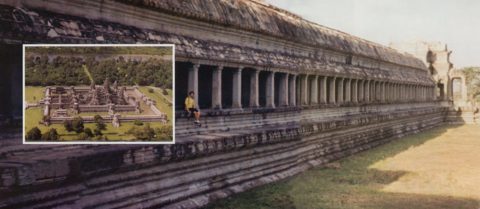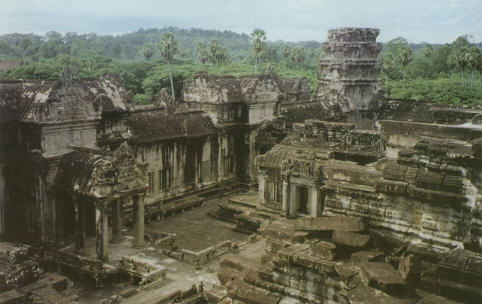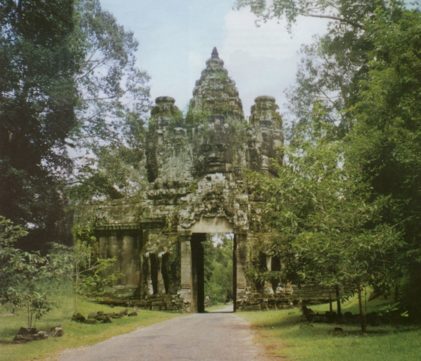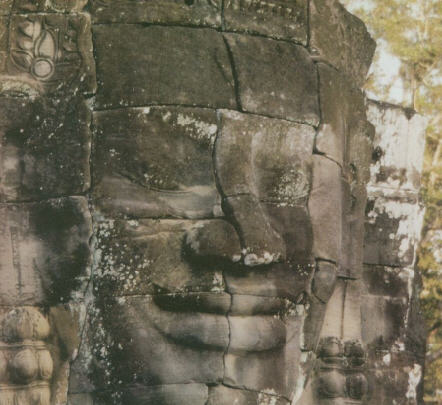
Ramachandra Gardner
The World's Largest Temple Complex
Though much of it lies in ruin, this centuries-old temple still evokes respect for the devotion of its builders.
IN OCTOBER 2000, I was in Bangkok serving my Guru Maharaja, Sridhara Swami. Because my visa was expiring, I had to leave Thailand to renew it. Choosing between Myanmar, Malaysia, and Cambodia, I thought Cambodia would be the most interesting, especially since I could visit Angkor Wat, the largest complex of religious buildings in the world.
Friends warned me, though, that Cambodia could be extremely dangerous. Land mines left over from the civil war still litter the landscape, and the remote areas have a high rate of armed robbery, kidnapping, and murder. I was disappointed to hear that and feared I'd have to change my plans, but after a day or two I met a few Americans who had lived in Bangkok for several years and had visited Angkor Wat recently. They said that Siam Reap, the town closest to Angkor Wat, was a perfectly safe place to stroll through even at night. The main route from the Thailand border to Siam Reap was safe too, but out at the temples I should stick to clearly marked trails.
Traveling as a shaven-headed monk in Vaisnava attire, I felt I'd be an unattractive target for criminals. In Bangkok everyone had been kind to me. As a monk, I could travel on local buses for free. So I hoped that as a monk in Cambodia I'd be treated the same way.
A Grueling Ride
After a seven-hour train ride, I reached the Cambodian border, where I packed into a truck with a few other tourists, and we started for Siam Reap. I was relieved to be driving with other foreigners. It seemed that Cambodia wasn't so dangerous after all, but it still looked damaged from war and had a bad economy, as we would soon find out. Our rainy-season drive on the pot-holed road reminded me of the famous Camel Trophy car race through the Amazon jungle. The 150 kilometers from the border to Siam Reap took eight painful hours. We had only one half-hour stop, where an ocean of kids tried to sell us bread, biscuits, and cold drinks.
Stiff and bruised, we reached Siam Reap late at night. A young man accompanying the driver offered us his guesthouse to stay in, so a Japanese man and I accepted his offer.
Seventy Temples
The next day I hired a guide nineteen-year-old Sopeak, who drove me on motorcycle to some of the seventy temples of Angkor Wat. After buying a one-day ticket, the first temple we went to was the Bayon, a Buddhist temple built around A. D. 1200 by Jayavarman VII. There we saw more than two hundred smiling faces of Avalokitesvara and many carvings on the outer wall of the first level depicting vivid scenes of life in twelfth century.

While climbing up to the main tower, I met a professor from England who was surprised to see a Krsna devote. He was interested to hear that the main temple of Angkor Wat was built for Lord Visnu, an expansion of Krsna, and that Vedic culture had great influence in Southeast Asia. I told him that even today people in Thailand, Indonesia, and other countries in the area worship Lord Brahma, Lord Siva, Ganesa, Garuda, and other demigods evidence that Vedic culture was spread all over the world, as stated in Srimad-Bhagavatam, Mahabharata, and Ramayana, a Vedic scripture still popular in Southeast Asia.
The next temples we visited were the Baphuon, a pyramidal representation of Mount Meru, built by Udayadityavarman II, and the Bakong, built by Indravarman I and dedicated to Lord Siva.
We also visited a few temples dedicated to Lord Buddha. In one of them I met four Buddhist monks who tried to figure out which sect of Buddhism I belong to.
In Angkor Thom, a fortified city where some of the temples are found, we came upon five monumental gates, each topped by four serene faces of Avalokitesvara; Terrace of Elephants, used for public ceremonies and decorated with bas-reliefs of Garuda and lions; and Terrace of the Leper King, on whose platform stands a statue of Lord Siva and whose front walls are decorated with carvings of seated apsaras, the heavenly dancing girls mentioned in the Vedas.
We ended the day with a visit to the main temple, because it's not possible to visit all seventy temples in one day, and probably not worth the effort. Sopeak told me that many of them are not much more than heaps of stone, having been destroyed by vegetation and vandalism.
Lord Visnu's Temple

To reach the main temple, we had to cross a wide moat that forms a rectangle 1.5 kilometers by 1.3 kilometers. From a distance we could see the central tower, which rests on the three-story building and rises 60 meters above the ground. At the entrance to the temple complex is an 800-meter-long series of a bas-reliefs, one of which one depicts the churning of the ocean of milk, with demons on the left and demigods on the right. Some reliefs depict the pastimes of Lord Ramacandra.
To reach Lord Visnu, we passed through three large square galleries and then up a narrow, steep staircase to the central tower. On seeing the 2.5-meter-tall deity of Lord Visnu with eight arms, wrapped in a saffron shawl, I amazed a few tourists by offering prayers and bowing my head to the floor. Worship of the deity still goes on. Two old women were selling fragrant, colorful, half-meter-long incense sticks that everyone could offer, and I took the opportunity to offer a few of them.
The temple was built by king Suryavarman II, a unifying monarch who fought to earn the title of absolute ruler. He campaigned in the east against Vietnam and the ancient nearby kingdom of Champa, and was the first Angkorean king to begin diplomatic relations with China.
Archeologists and astronomers have found correlations between dimensions of the temple and important numbers in the Vedas. For example, distances between the entrances and the main tower correspond exactly to the length of the four Vedic ages. At the summer solstice an observer standing in front of the west entrance can see the sun rise directly over the central tower. This day, June 21, marked the beginning of the solar year for Indian astronomers and was sacred to King Suryavarman, whose name means "protected by the sun." A devotee of Visnu, he started building the temple in 1112, at the beginning of his reign. It was completed after his death, about 1150. The deity of Visnu was installed in July 1131, probably when Suryavarman turned thirty-three a significant number in Vedic cosmology.
Sanskrit poems of that time describe the history of Angkor Wat, and kings of Angkor Wat had Sanskrit names. The name Angkor derives from the Sanskrit word nagara, meaning "city." From A.D. 802 to 1431, Cambodia known in its own inscriptions as Kambuja-desa was the mightiest kingdom in Southeast Asia.
More Vedic Links
Among the many kings whose reigns showed evidence of Vedic links, Jasovarman, who ruled from 889 to 910, established the royal city named Sri Yasodharapura.  He had monasteries built for sects that honored Siva, Visnu, and Buddha. Inscriptions from his time show him to have been aware of the grandeur of Indian civilization and tolerant of different religious beliefs. One reads, "His eyes were the Veda; His glory was like a roar in all directions; his virtues made up his name."
He had monasteries built for sects that honored Siva, Visnu, and Buddha. Inscriptions from his time show him to have been aware of the grandeur of Indian civilization and tolerant of different religious beliefs. One reads, "His eyes were the Veda; His glory was like a roar in all directions; his virtues made up his name."
At dusk we drove back to Siam Reap. I was deeply impressed by the devotion and opulence with which King Suryavarman II had glorified Lord Visnu. The greatness of Angkor Wat is known all over the world, attracting hundreds of tourists daily. With my new visa in hand, I returned to Bangkok hoping that people in Cambodia, having witnessed firsthand the curse of a materialistic, godless society, will again take up their now almost lost Vedic civilization.
Adbhuta Hari Dasa joined ISKCON in 1994 in Croatia. He serves as personal assistant to his spiritual master, Sridhara Swami.
Online Extra
See an expanded photo gallery for this article at www.krishna.com/372
